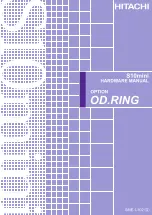
REQUIREMENT
Electric shock hazards exist so that you might suffer burns or become
electrocuted. Further, the system might malfunction due to noise interference.
Therefore, ground the line ground (LG), frame ground (FG), and shield wire
(SHD) as directed below:
•
Insulate the mount base from the enclosure. To keep the mount base
insulated, avoid removing the insulation sheets that are supplied with the mount
base.
•
The LG is a ground terminal for power supply noise. The FG and SHD are
ground terminals for the noise in the communication module and other external
interface lines. To avoid interference between the ground terminals,
separately ground the LG and FG.
•
Ground the module’s FG by shorting it to the mount base’s FG terminal. Note,
however, that the FG terminal for each remote I/O line or JPCN-1 line must be
connected separately to a single place on the terminating side.
REQUIREMENT
A surge voltage may cause hardware units to malfunction or to be damaged.
Where a coil such as one in an electromechanical relay is connected to the
PCs’ OK output circuit, protect the relay with a surge-absorbing diode that is
capable of withstanding a peak inverse voltage of at least 10 times the circuit
voltage and has a forward current equal to or larger than the load current.
Excessive accumulation of heat in the cubicle may cause a fire or hardware
failure. When the temperature in the cubicle reaches 48°C or higher, the
maximum output current of the power supply module is limited. At 55°C, for
instance, it is limited to 5.85 A. Where this is very likely, install a cooling fan
in the cubicle or reduce the number of modules installed therein.
If the battery is handled improperly, it may catch fire or explode. Some used
batteries may still have a considerable amount of charge. To deliver such
used batteries to a waste disposal site safely, follow the general rules for
collection, packing, and transportation. For concrete methods of packing and
transportation, consult with professionals of your local waste disposal
business.
Summary of Contents for LQE010
Page 1: ......
Page 2: ......
Page 17: ...1 BEFORE USE ...
Page 21: ...2 SPECIFICATIONS ...
Page 23: ...3 NAMES AND FUNCTIONS OF EACH PART AND CABLING ...
Page 27: ...4 USER GUIDE ...
Page 39: ...5 OPERATION ...
Page 46: ...6 MAINTENANCE ...
Page 63: ...7 TROUBLESHOOTING ...
Page 79: ...APPENDIX ...






































